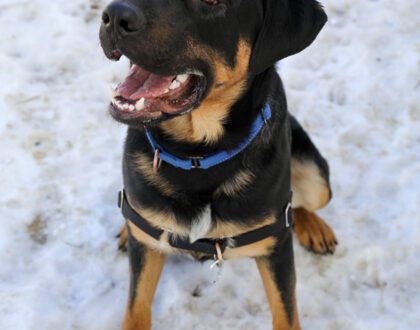Double Merles, Double the Love
By: Judy Hamontre, AVHS Vice-chair
“Her white coat drew my eye to her photo on an online adoption list. Then I learned her story. She had been saved from a breeder who was planning to shoot her because of her colorless coat, odd looking eyes and deafness, the result of her being a double merle. I did not hesitate to adopt this adorable Australian shepherd puppy. I named her Keller.”
“I worked hard to train Keller in obedience using only hand signals, and eventually the dog who was nearly killed for her disabilities was outperforming hearing dogs.”
This is the story Amanda Fuller, an animal welfare professional, relates about the double merle dog she adopted. A story that led her to become a passionate advocate for double merles, helping to establish Double Merle Awareness Day, which occurs the third Saturday in May each year, not to be confused with National Merle Awareness Day, September 8, founded by a different couple. The hope for both days is to create awareness about a reckless breeding practice, a practice that has been banned by the UK Kennel Club, and to encourage potential pet owners to consider adopting special needs pets.
Canine coats come in many different colors and patterns. Swirled, mottled markings, known as merles, are pretty and popular. This means breeders can often charge more for dogs with a merle coat. While there are many responsible dog breeders, there are also those who simply seek to increase their profits. At times, these heedless breeders may allow two merles to breed together, in the hopes of gaining more merle puppies, which is unnecessary and can result in what is known as ‘double merles’.
When a merle dog breeds with a solid coated dog, the puppies have a fifty-fifty chance of inheriting the merle gene from their single merle parent. When two merle dogs breed, the odds of having merle coated puppies do not increase, but there is a 25 percent chance a pup will inherit the merle gene from both parents and be a double merle.
Double merles often have a predominantly white coat due to decreased pigmentation. Because of the decreased pigmentation, these dogs are at a high risk for hearing and sight impairments. Sight impairments can be mild to total blindness. Some dogs are even born without eyes. Hearing impairments range from mild to complete deafness. Some double merles are both vision and hearing impaired.
The American Kennel Club recognizes merle as an acceptable pattern in the following breeds: Australian shepherd, border collie, corgi, Catahoula leopard, chihuahua, dachshund, Great Dane, miniature American shepherd (aka mini Aussie), old English sheepdog, and Shetland sheepdog. However, these are not the only breeds that could have the merle gene. Also, there are other genetic combinations that can produce white fur, so a white coat does not necessarily mean they are a double merle.
What is important is that two merles should not be bred together, especially knowing that the most unscrupulous breeders often euthanize double merle puppies, and sometimes in not very humane ways. One can hope that these breeders would instead choose to surrender these pups to a shelter for a loving family to adopt.
There are many animal welfare organizations that specialize in rescuing animals with special needs. Bringing a special needs pup into your home has its challenges, but Amanda would tell you her double merle, Keller, is double the love! When you’re looking for your next dog, please consider adopting from a shelter or rescue. Many shelters across the country are still struggling due to a lack of time, space, and resources for the animals in their care, which leads to the euthanaisa of healthy, adoptable animals. You can make a difference by opening your home to a special animal in need and adopting today!
Recommended Posts

Get on Board for AVHS
May 02, 2024

Good Pets. Good Kids. Charming Portraits.
April 13, 2024

Reflecting on 2023
April 06, 2024
